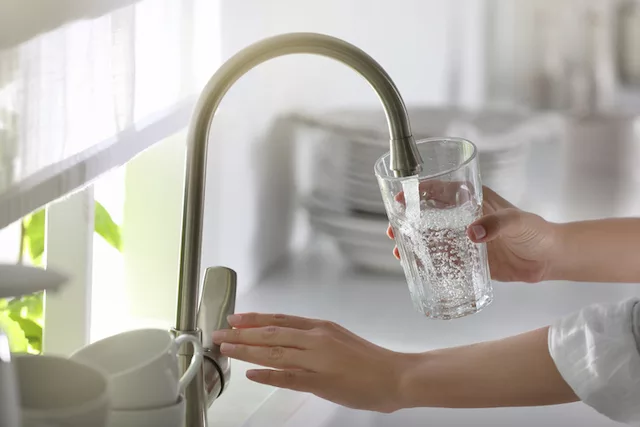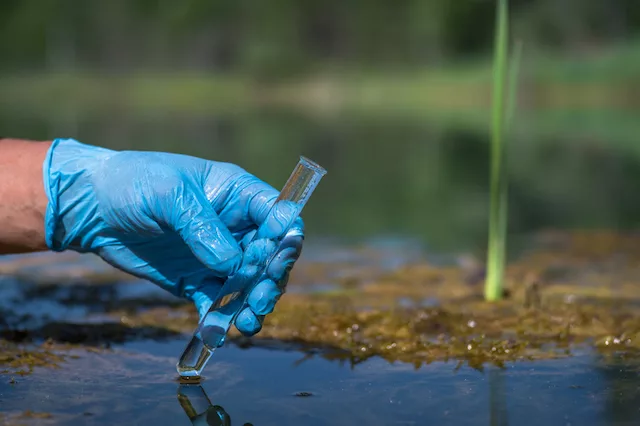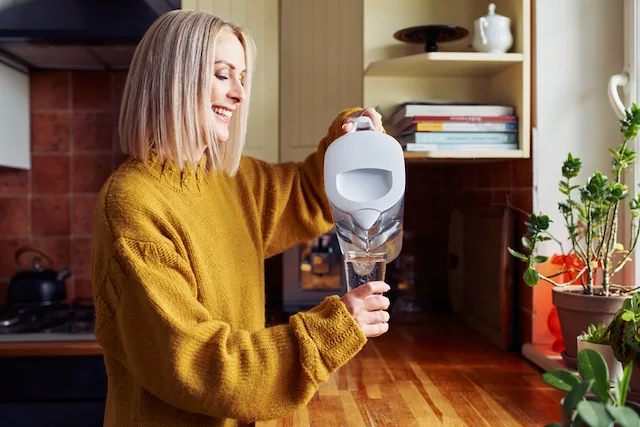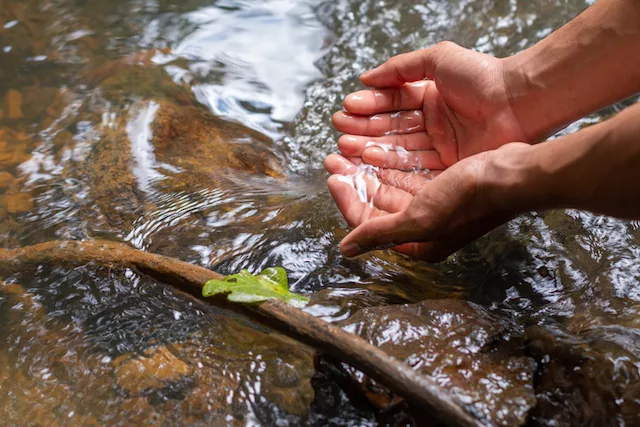Dive deep into why you should be filling up on filtered water to safeguard your health. This article explores the adverse effects of contaminated tap water, and offers sustainable and affordable solutions to ensure clean and safe drinking water for you and yours.
You visit your kitchen and bathroom sinks multiple times a day to fill up your water bottle or brush your teeth. As a kid, you probably drank out of the garden hose more than once. But have you ever stopped to wonder what might be lurking in your tap water?
When you turn on your faucet, you trust that what comes out is safe to bathe in, wash your dishes with and drink. However, this ordinary substance may not be as innocuous as we’ve been led to believe. There’s a growing concern about tap water contamination — even community water systems that meet national drinking water standards. Is tap water safe to drink?

The increased interest in tap water safety, especially following public health tragedies like the Flint water crisis, has encouraged more data to be collected on our local drinking water systems. One big concern is the rising rates of cancer and other diseases, leaving us to question whether the tap water we rely on every day may be a factor.
Let’s take a closer look at why you should filter your tap water and how you can ensure yours is clean and safe.
The Reality of Bad Tap Water
Water is vital to our lives, but we live in a time when it’s important to proceed with caution. The presence of contaminants in your tap water depends on a number of factors, such as where you live, the water treatment processes in your area, and the condition of the water infrastructure in place.
While the intention of municipal water treatment facilities is to provide safe drinking water, there can still be trace amounts of substances that can cause harm over time. Even the Centers for Disease Control states, “Public water is regulated but can sometimes get contaminated.” And as it turns out, that appears to be happening more often than most of us are aware.
In 1974, the Federal Safe Drinking Water Act was enacted to establish EPA standards for certain tap water contaminants, like lead, copper, and arsenic. While the act was updated in 1986 and again in 1996, progress has been slow as contamination worsens in many areas around the country.
For instance, a new 2023 study conducted by the U.S. Geological Survey and published in Environmental International found that nearly half of the nation’s water could be contaminated with one of the thousands of harmful per-and poly-fluoroalkyl substances.
Plenty of other contaminants make their way into the water system every day, like oral contraceptives and other pharmaceutical residues, pesticides and heavy metals. Plus, water travels many miles through the pipeline before it reaches us, picking up things along the way on top of what may already be in it.
The health risks of our exposure to them are plenty, including an increased risk for compromised immunity, hormone disruption, and cancer, to name a few.

The Link Between Contaminated Tap Water and Rising Cancer Rates
The Environmental Working Group (EWG) conducted a cumulative assessment of the lifetime risk of cancer from drinking contaminated tap water, which was published in Heliyon in 2019.
This involved examining the combined health effects of 22 known cancer-causing contaminants in the water they tested. This water came from nearly 49,000 community water systems in the United States, which reach an estimated 279 million Americans.
The researchers concluded that regular exposure to the carcinogens in contaminated tap water would result in around 100,000 cases of cancer over the lifetimes of those drinking it.
So what potential carcinogens might be found in tap water and how can they impact public health? The presence of these potential carcinogens in tap water can vary depending on your location, the condition of infrastructure, and the treatment processes employed.
Here are some of the most common.
Per-and poly-fluoroalkyl substances (PFAS)
PFAS are man-made chemicals known to be associated with a higher risk for obesity, heart health issues, cancers, infertility, and birth defects. They’re found in things like nonstick cookware, food wrappers, cosmetics, and more. PFAS are also known as “forever chemicals” because they are widely used, break down slowly, and persist in the environment.
Heavy metals
Lead, arsenic, cadmium, and mercury are known or suspected carcinogens. They can find their way into tap water through natural sources, agricultural runoff, industrial waste, and corroded plumbing.
Radon
Radon is a naturally occurring radioactive gas that can dissolve in groundwater and get into tap water. Long-term ingestion of radon-contaminated water has been associated with an increased risk of stomach cancer.
Disinfection byproducts
Chlorine and other disinfectants are commonly used to treat water and kill harmful microorganisms. But when they react with other naturally occurring compounds in water, they can form byproducts associated with a higher risk of certain cancers.
Pesticides and herbicides
Agricultural practices can introduce pesticides and herbicides into water. Some of these chemicals, such as atrazine and glyphosate, are very likely carcinogens.
Nitrates
Nitrates are common water contaminants, usually coming from fertilizers and septic systems. When they’re present in high amounts, nitrates can form cancer-causing nitrosamines.
Industrial chemicals
Compounds like polychlorinated biphenyls (PCBs), polycyclic aromatic hydrocarbons (PAHs), and volatile organic compounds (VOCs) have been linked to cancer in humans. These can enter the water from industrial processes and waste disposal.
The Hidden Dangers: Side Effects of Bad Tap Water
Nobody wants to hear that their drinking water might contain cancer-causing substances. Yes, public water systems are monitored and tested against safety and quality standards. But the odds that your drinking water is totally free from harmful substances are pretty much zero.
Some groups are at a higher risk for adverse health effects from their water, such as those who have compromised immune systems, are very young or elderly, or have specific medical conditions. But none of us want to be drinking them.
What could potentially happen if you’ve been drinking contaminated water? Here are some of the hidden dangers of always drinking straight from the tap.
Gastrointestinal issues
If your tap water contains high levels of contaminants, you might experience digestive symptoms. One reason may be that tap water is a vehicle for microbiome disruptors. Some of the most common include nausea, vomiting, and loss of appetite. More severe cases may lead to diarrhea, bloody stools, abdominal cramps, or even kidney failure, depending on what’s in the water.
Skin problems
Being exposed to high doses of chemicals in your tap water may lead to noticeable skin changes. For example, skin discoloration may occur or more seriously, skin lesions and cancers from high amounts of arsenic.
Hormone disruption
Drinking tap water is a known risk for ingesting endocrine-disrupting compounds. These may come from a number of residues that enter the drinking water system, including birth control pills, according to the Natural Resources Defense Council.
Compromised immune function
Some compounds in tap water may be immunotoxic. Examples include metals like arsenic, cadmium, chromium, lead, and copper, PFAS, phthalates and bisphenols. While some of these are known to be endocrine disruptors, they have also been found to activate pathways involved in autoimmune disease development.
You can’t control every water source you’re exposed to, but it’s important to take precautions to safeguard against potential health risks in your home.
Filtration Solutions for Clean Water
“Before considering a water filter, it’s beneficial to understand the quality of your local water,” says registered dietitian Kristin Draayer, MS, RDN. She continues, “A water quality report can often be found online and will provide insight into the contaminants present in your local supply.” Then, you can make an informed decision regarding the type of filtration solution you need.
But hold on, this doesn’t mean you need to panic and buy everything on the market. There are several options when it comes to ensuring clean drinking water at home.
Activated carbon filters
These filters are full of tiny pellets of activated carbon. When water passes through them, anything unwanted gets stuck in the surface of the carbon pieces and doesn’t end up in your filtered water.
- Pros: Efficiently removes metals like lead and copper, organic contaminants that cause odor and taste problems, and some types remove pesticides and solvents.
- Cons: Does not remove bacteria, nitrates, or dissolved minerals.
Reverse osmosis system
Reverse osmosis works by filtering tap water through a semipermeable membrane, leaving large molecules behind.
- Pros: Effectively removes sodium and nitrates, possibly reduces the amount of pesticides, dioxins, chloroform, and petrochemicals, and gets rid of bad smells, colors, and tastes.
- Cons: Does not remove all inorganic and organic contaminants.
Pitcher filters
These are pitchers that are filled from the top and allow water to pass through filters before being ready to drink.
- Pros: Inexpensive, easy to use, and minimal setup required.
- Cons: Capabilities vary by model, filters are slow compared to other options, and filters require replacement every few months.
When shopping for a filter, registered dietitian Maya Oueichek, MBA, RDN suggests keeping a few key tips in mind. “Ensure that the filter effectively removes the contaminants you are concerned about. There are many different types of water filters available, and each type is designed to remove specific contaminants,” she says.
Common contaminants that water filters can effectively remove include lead, chlorine, pesticides, and herbicides. But not all filters are created the same, so you have to compare their capabilities depending on your priorities.
Furthermore, Oueicheck says, “When selecting a water filter, it is crucial to choose one that is certified by a third-party organization, such as NSF International. This step is vital to ensure that you are investing in a device that will deliver the expected results.”
And whatever filter you choose, remember to use and replace it according to the manufacturer’s instructions for the most effectiveness.

Sustainable and Affordable Water Filtering Options
In addition to the options above, there are plenty of other sustainable and affordable options to help clean your water and ease your mind.
For instance, purchase a reusable water bottle that has a small built-in filter, so you never have to worry about where you’re refilling your water from when you’re on the go. They might filter the water as you fill your bottle or as you drink from it.
When choosing a reusable water bottle, consider one made with ceramic. Why? Ceramic appears to offer some natural antimicrobial and purification capabilities that can help clean your drinking water.
Another great option is to use activated charcoal sticks, which are porous and easily absorb contaminants and impurities. All you have to do is place them in your tap water, where they will begin to work.
Not only are these options convenient and versatile, but they’re also a great way to reduce your plastic waste contribution. Plastic currently makes up 85% of ocean waste, but it doesn’t just stay there. It reaches many other aspects of the environment, not to mention the human body.
And according to a report by the UN Environment Programme, global plastic pollution is on track to double between now and 2030. Sustainable water filtering options are just one way to help.
DIY Water Filters: A Budget-Friendly Approach
If you’re on a tight budget, you can still take action to improve the quality and safety of your drinking water. If purchasing a water filtration system isn’t in the cards right now, consider DIY water filter options instead, such as:
- Coffee filters: While these can’t guarantee water safety, they can help with removing some of the larger particles that may be present.
- Cheesecloth: A similar approach to using coffee filters, cheesecloth can be used to remove larger particles from your drinking water.
- Homemade charcoal filter: This option uses crushed activated charcoal powder, and a layer of multi-sized particles for filtration, such as cloth, sand, and pebbles. Water will be filtered through these layers using a plastic bottle that you’ve cut the bottom off of and poked a hole through the lid, like a funnel. You might also choose to boil your water thereafter, but this step is generally used in the wilderness or if your community has a boil water advisory.
In the United States, there are many organizations working to advocate for better water safety regulations, raise awareness about drinking water safety, and improve water quality in our communities.
Their success relies on community involvement and strategic partnerships to make long-term impacts. Get involved or consider supporting their causes to make a broader impact.

Some of these groups include:
- Clean Water Action: A grassroots organization focused on protecting water resources and advocating for clean and safe drinking water.
- Environmental Working Group: While they cover a wide range of environmental issues, EWG also conducts research and advocacy related to drinking water quality, contaminant exposure, and the health impacts of water pollution.
- Clean Water Fund: An organization that partners with communities and grassroots groups to advocate for clean and affordable drinking water.
- Food & Water Watch: An organization that campaigns for safe and accessible drinking water for all Americans. They work to hold governments and corporations accountable for water quality and sustainable water management.
- Natural Resources Defense Council: In addition to their broader environmental advocacy, they also focus on water quality and access to safe drinking water, using legal action and advocacy to protect communities.
- Water Research Foundation: This nonprofit organization supports research related to water quality and treatment, including drinking water. Their work helps inform policy and best practices for water utilities.
Filtering Water for All: Global Outreach
Drinking water contamination reaches far beyond our own kitchens and communities, affecting people worldwide. Advocating for global efforts to improve water quality is critical for protecting public and environmental health far and wide.
There are many international organizations working tirelessly to address these issues around the globe, with the hope that one day nobody will have to go without clean drinking water. Supporting these groups is imperative to help provide clean water solutions to underserved regions.
Some of the most prominent global drinking water advocacy organizations include:
- Charity:Water: A non-profit organization that focuses on providing clean and safe drinking water to people in developing countries. They fund various water projects and work closely with local partners to ensure sustainable solutions.
- Water.org: Founded by Gary White and Matt Damon, Water.org is dedicated to empowering communities with access to safe water through innovative partnerships.
- The Clean Water Action: A grassroots organization advocating for clean, safe, and affordable water for all. They address water pollution, drinking water protection, and the impact of industrial and agricultural practices on water quality.
- Global Water Intelligence: A platform that provides insight and analyses on water-related issues, including water quality, management, and investment.
- Water for People: Working in various countries, Water for People emphasizes sustainable solutions for clean water and sanitation, incorporating the principles of community involvement and long-term impact.
- Blue Planet Network: An online platform connecting donors and communities to fund clean water and sanitation projects worldwide.
- The Alliance for Water Stewardship: An international organization that collaborates with businesses, governments, and people to promote responsible water use and management.
Conclusion
Water is essential to life, but that doesn’t mean we should overly trust or settle for whatever comes out of the tap where we live. Despite being regulated by local authorities, community drinking water is very likely to contain at least trace amounts of substances you don’t want in your body. Consuming them over the long term may increase your risk for numerous health effects, including serious diseases like cancer.
Take action to filter your drinking water as soon as possible. Explore sustainable, affordable, and convenient options that work best with your needs and lifestyle. Get involved with local and global efforts to advocate for safe drinking water far and wide. Protect yourself and your loved ones.
For more information on water filtration and tips for safer drinking water, check out NSF International’s Consumer Drinking Water Resources and the EWG’s Guide to Safe Drinking Water.
Happy Hydrating!




